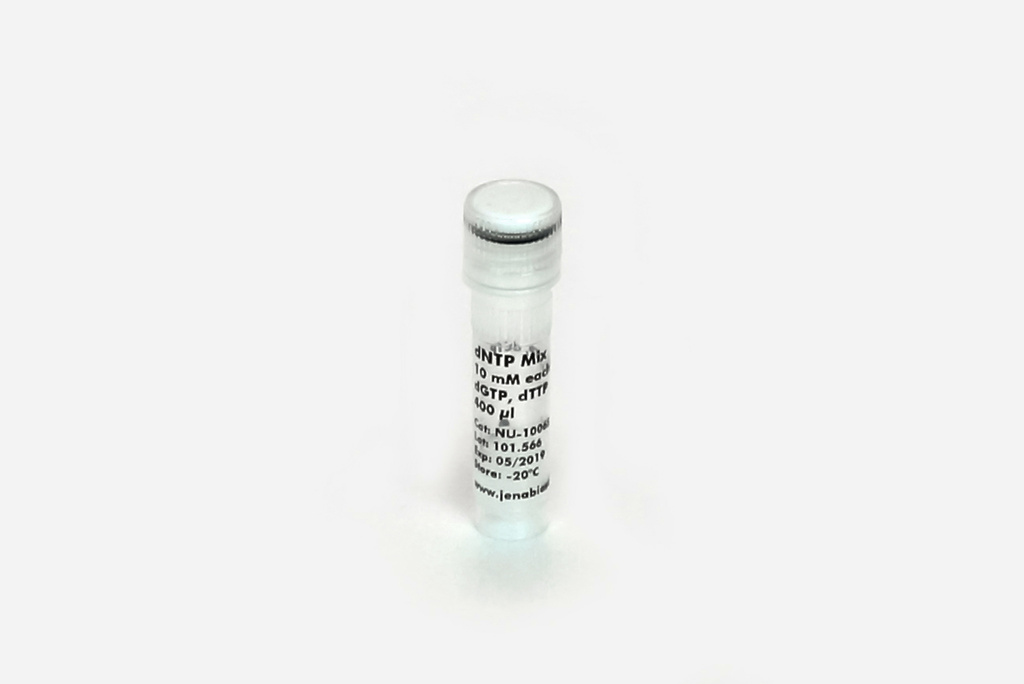qPCR SybrMaster lowROX
Detailní popis
For in vitro use only!
Shipping: shipped on blue ice
Storage Conditions: store at -20 °C
avoid freeze/thaw cycles, store dark
Storage at 4 °C for up to 3 months possible.
Shelf Life: 12 months
Form: liquid
Concentration: 2x conc.
Spectroscopic Properties: λexc 494 nm (bound to DNA), λem 521 nm (bound to DNA)
Description:
qPCR SybrMaster lowROX is designed for quantitative real-time analysis of DNA samples. The mix contains all reagents required for qPCR (except template and primers) in a premixed 2x concentrated ready-to-use solution. It is recommended for routine PCR applications, high throughput PCR or genotyping and provides an improved specificity and sensitivity when amplifying low-copy-number targets or working with complex backgrounds.
The mix is based on an optimized hot-start polymerase. Its activity is blocked by antibody at ambient temperature and switched on automatically at the onset of the initial denaturation. The thermal activation prevents the extension of nonspecifically annealed primers and primer-dimer formation at low temperatures during PCR setup.
The fluorescent DNA stain SYBR® Green intercalates into the amplification product during the PCR process and allows the direct quantification of target DNA without the need to synthesize sequence-specific labeled probes (i.g. TaqMan® Probes).
The reaction chemistry of the kit is optimized for instruments that are compatible with the evaluation of a low ROX reference signal.
SYBR® Green Fluorescent DNA Stain
SYBR® Green Fluorescent DNA Stain is a superior DNA intercalator dye specially developed for DNA analysis applications including real-time PCR (qPCR). Upon binding to DNA, the non-fluorescent dye becomes highly fluorescent while showing no detectable inhibition to the PCR process. The dye is extremely stable, providing convenience during routine handling.
SYBR® Green is in contrast to EvaGreen® not recommended for high-resolution melting curve analysis (HRM).
To perform the SYBR® Green-based assay simply select the optical setting for SYBR® Green on the detection instrument.
ROX reference dye:
The qPCR SybrMaster with lowROX contains 50 nM ROX passive reference dye in the final assay. The dye does not take part in the PCR reaction but allows to normalize for non-PCR related signal variation and provides a baseline in multiplex reactions.
Content:
qPCR SybrMaster lowROX (red cap)
antibody-blocked hot start polymerase, dATP, dCTP, dGTP, dTTP, KCl, (NH4)2SO4, MgCl2, SYBR® Green DNA intercalator dye, 100 nM ROX, additives and stabilizers
PCR-grade water
Preparation of the qPCR master mix:
The preparation of a master mix is crucial in quantitative PCR reactions to reduce pipetting errors. Prepare a master mix of all components except template as specified. A reaction volume of 20-50 μl is recommended for most real-time instruments. Prepare 13 volumes of master mix for 12 samples or a triple-set of 4 samples. Pipet with sterile filter tips and minimize the exposure of the master mix to light. Perform the setup in an area separate from DNA preparation or analysis. No-template controls should be included in all amplifications.
| component | 20 μl assay |
50 μl assay |
final conc. |
| qPCR SybrMaster with lowROX |
10 μl | 25 μl | 1x |
| primer forward (10 μM)1) |
0.6 μl | 1.5 μl | 300 nM |
| primer reverse (10 μM)1) |
0.6 μl | 1.5 μl | 300 nM |
| template DNA | x μl | x μl | - |
| PCR-grade water | fill up to 20 μl |
fill up to 50 μl |
- |
1) The optimal concentration of each primer may vary from 100 to 500 nM.
Dispensing the master mix:
Vortex the master mix thoroughly to assure homogeneity and dispense the mix into real-time PCR tubes or wells of the PCR plate.
Addition of template DNA:
Add the remaining x μl of sample/template DNA to each reaction vessel containing the master mix and cap or seal the tubes/plate. Do not exceed 500 ng DNA per reaction as final concentration. Tubes or plates should be centrifuged before cycling to remove possible bubbles.
Recommended cycling conditions:
| Initial denaturation and polymerase activation |
95 °C | 2 min | 1x |
| Denaturation | 95 °C | 15 sec | 35-45x |
| Annealing and elongation |
60-65 °C3) | 1 min4) | 35-45x |
3) The annealing temperature depends on the melting temperature of used primers.
4) The elongation time depends on the length of the amplicon. A time of 30 - 60 sec. for a fragment of up to 500 bp is recommended.
For optimal specificity and amplification an individual optimization of the recommended parameters, especially of the annealing temperature may be necessary for each new combination of template DNA and primer pair.
SYBR® is a registered trademark of Invitrogen Corporation, Carlsbad, California, USA
Related products:
- Dual-labeled DNA probes
Hodnocení produktu
Produkt zatím nikdo nehodnotil, buďte první!

